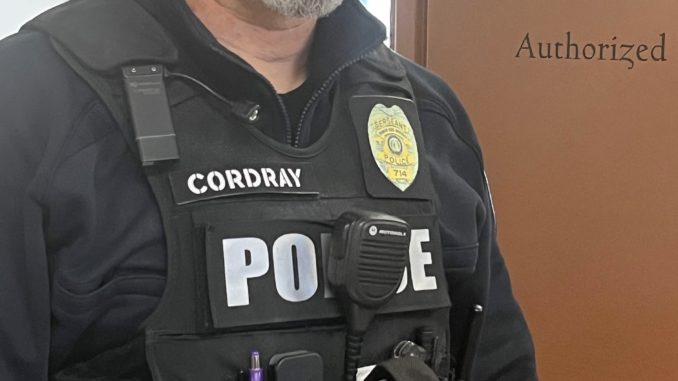
Truman State University’s Department of Public Safety has begun to use body worn cameras to increase professionalism and transparency, DPS Chief Sara Seifert said.
The cameras were purchased through a federal “Small, Rural, Tribal Body-Worn Camera” grant program specifically intended for agencies with less than 50 officers, Seifert said. DPS officers began using the cameras about a week ago.
DPS was one of 20 to receive a perfect score on the grant process out of 300 or 400 departments to apply, said Lieutenant Jeremy Cordray.
Cordray applied for the grant on behalf of the department about a year ago. Seifert said the department received the grant during the fall, they ordered the cameras during November, received them during December and began using them during January.
Seifert said it was a proactive effort to be transparent. If the Truman community has any doubts about DPS’s actions, they can pull up camera footage for the community to know what kinds of services they are providing.
Another reason the department wanted cameras is for documentation and evidence. Seifert said the cameras are also a great way to deescalate situations.
“I feel like if people know that they’re being videotaped and that [there is] the potential for the whole world to see it, one the officer’s going to perform better, and two, if the community that we come into contact with knows that they are being taped, I think verbal de-escalation will work better,” Seifert said.
The Kirksville Police and Sheriff’s Departments, the Adair County Police Department and the Missouri State Highway Patrol all received body cameras before DPS because of their bigger budgets, Seifert said.
In the past, the KPD’s footage has been helpful to review for DPS when they have worked on the same incident, Seifert said. Being able to review the footage allowed them to see how it can be helpful to make officers and the community more professional and are helpful in resolving issues quickly.
“I think that it’s important because, just [in] this day and age, that’s the expectation,” Cordray said. “So that’s a big thing, and if you don’t have that, you’re almost … looked at differently, and so we want to be a transparent police department and kind of have a positive image that we don’t have to be looked at in a negative light. We don’t have anything to hide.”
Cordray said larger departments might rely on the footage to review complaints or use of force incidents. However, since DPS is a smaller department with barely any complaints, the footage will be for increased transparency and to have footage available to review.
Officers will turn on the cameras any time an officer has contact with a community member, Seifert said. Since Missouri’s recording policy is one-party consent, officers will not have to ask before they start recording. The cameras will beep every 60 seconds while recording. Officers will download their footage of encounters and categorize them at the end of their shifts.
Seifert said the storage time of the recording will depend on the type of encounter. Recordings will be categorized as contacts with no conflict, contacts with possible conflict, misdemeanors, felonies, arson, accidents, use of force or extended felonies. Recordings will be kept for lengths of time from 30 days to forever, depending on the category.
Seifert said categorizing the footage would likely take less than 10 minutes at the end of a shift.
The SRT BWC grant was one of two the department applied for, Cordray said.
The SRT BWC grant is a matching in-kind grant, meaning DPS must match the grant’s $18,000 with their own $18,000, mostly in work hours related to the cameras such as training hours and footage review hours, Seifert said.
A condition of the grant is that DPS must report on various statistics related to the cameras such as the number of officer complaints or use of force numbers for the next three years.
The grant covered all costs associated with the cameras except the software and training, Seifert said. The cost for Truman was $3,000 out of a $25,000 total cost.
A condition of the grant was that officers would be trained to use the cameras, which Cordray conducted, he said. He also was in charge of spot checking footage.
Cordray said some officers did not like seeing themselves on camera, so they were somewhat apprehensive, but that officers did not have any major problems with the cameras. They are still in a training phase and adjusting to remembering to turn the cameras on.
Seifert said she was wary about how the officers would respond to the decision to use cameras, but the officers received the news well. She said they were helpful in writing reports and showing people the situation from the officer’s perspective.
For example, footage can show an intoxicated person’s slurred speech and watery eyes through the eyes of a police officer, Seifert said. She said the only downside is that the cameras have a limited scope.
DPS is in the process of creating a form for the public to request footage. Private information will be redacted, Seifert said. There will be a fee associated with the amount of time spent preparing the footage, time spent redacting information and any storage materials.
Cordray said he wanted students to feel comfortable with the cameras, and he thinks they will be positive for the community.
“I’m excited about the program — the officers are excited about the program,” Seifert said. “We definitely — we’re committed to the Truman community and providing the best service we can, and we are excited about the transparency and kind of showcasing our professionalism to the students.”
